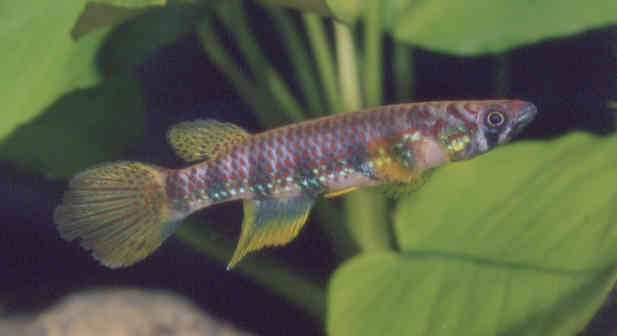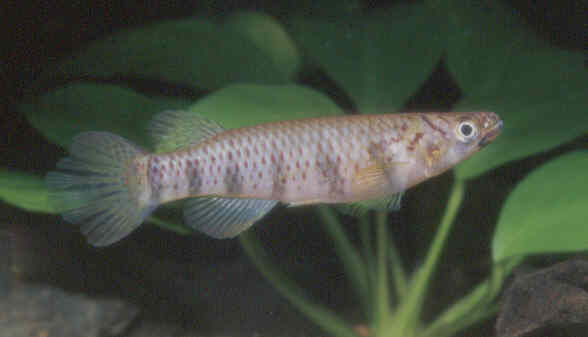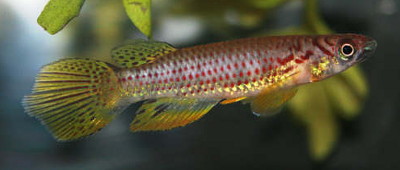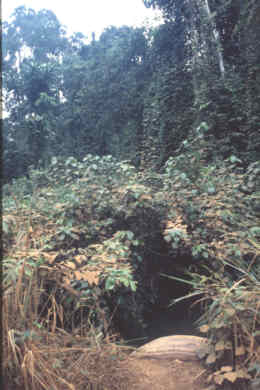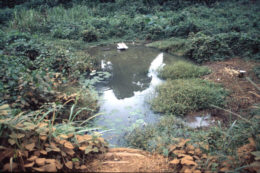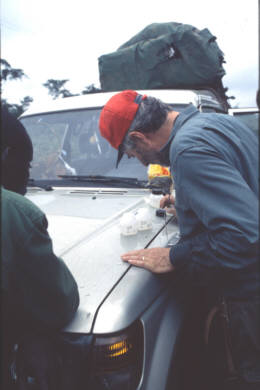Epiplatys huberi (Radda & Pürzl 1981)
|
N'dendé. Wild male.
|
N'dendé. Wild female.
|
The above photos were used in the original description.
| Meaning of Name |
After Jean Henri Huber, French ichthyologist & author of many killifish publications. | |||
| First Description |
Radda A.C. & Pürzl E. 1981. Aplocheilus (Epiplatys) huberi sp. nov., eine neue Hechtlingsart aus südwest Gabun. Aquaria 28: p 193-199, 8 figures, map. | |||
| Size |
6·5 cm | |||
| Meristics |
D = 9-10, A = 14-15, D/A = +10, ll = 29-30 (+3) (Radda & Pürzl 1981) | |||
| Karyotype |
n = 24, A = 20 (Radda & Pürzl 1981) | |||
| Sub-Genus |
| |||
| Group |
multifasciatus | |||
| Synonyms |
| |||
Populations
|
Bandi - Pronounced Bundy.
A village 32kms east of Mouila towards Yéno. Douengui - GJS
00 / 22 - From material kindly
sent to me by Mogens Juhl - "In an area near a river that was divided
into two, each just as wide as the main river, but half as deep. It
was still some 10 meters wide, but this part was possible to enter. | |||
| Type Locality |
N'Dendé, situated on the road towards
Lebamba in the Ngunié Province, southwestern Gabon. The biotope
was a forest creek. | |||
| Distribution |
Mogens Juhl collected this sp. from N'Dendé to Mouila. - "Everywhere we tried to collect killies on the way to Mouila we found E.huberi. All went into alcohol for the museum. It seemed that there was very little variation among the different populations, not more than you find within one population". http://homepage.uibk.ac.at/homepage/c102/c102mr/epiplaty/huberi.htm | |||
| Habitat |
Rainforest creeks & small
rivers on the southwestern slopes of the Du Chaillu Massif. PEG 93/2 - Stream 1·5 m wide & 20cm deep. Clear, slightly brownish water. No measurements of water taken but this other areas in this vicinity measured 30-50 µ S, temperature 23-25°C, pH 6 - 6·7. Sympatric sp. in this location - (A form of) A.exigoideum, Plataplocheilus cabindae, Barbus sp.. Plants (Aponogeton sp.) were found in the stream as it was open to daylight by the roadside. | |||
| Distinguishing Characteristics | The sides of the body appear 'brassy' with bright reflective scales making up a small percentage of this area. | |||
| Colour/Pattern Variability | Low | |||
| History |
First collected by Dr.J.H.Huber in 1978 in Congo Brazzaville. The specimens used as types were collected by Hofmann & Pürzl in June 1980 in a small forest stream situated on the southwestern slopes of the Gabon Chaillu Massif. The population from N'dendé was collected on the 22nd June 1980 by Hofmann & Pürzl on there GHP 80 trip towards the town of Lebamba, southwest Gabon (GHP 80 / 20). Guido Passaro & Wolfgang Eberl collected young fish in July 1993 at Bandi, 32 km east of Mouila towards Yéno, Gabon. This was a stream called Moyambi. Fish were returned to Germany & bred but no photos of wild fish are thought to have been taken. In a trip from December 25th - January 6th, 1996 Guido Passaro & Wolfgang Eberl again collected (10 young fish) at the same stream location. Eberl kept the fish & later passed on 2 pairs to Norbert Dadaniak & Reinhard Lütje. Reinhard photographed the fish. Other fish from Eberl were passed to Karl-Heinz Genzel for breeding. Collected in July/August 2000 by Robert Guggenbühl, Pascal Sewer & Mogens Juhl at locations GJS 00/20, 22, 23, 24, 26 | |||
| Breeding Notes |
I have kept this species on a couple of occaisions. The first pair refused to lay but the second pair layed quite freely in 100% rainwater. The tank received full natural daylight. Reports suggest they are difficult to breed & not prolific. My pair layed regularly in top & bottom mops but eggs were few in number. Water incubation took about 14 days. Sexual maturity is reported to take 7-8 months. Jaroslav Kadlec in BKA newsletter No.212, April
1983 put an article together on this sp. He bred them in a 20 litre
tank, pH 6-7, DH 5-15 although these measurements were not regarded
as critical. Floating plants were included in the setup. They were not
observed to be a territorial sp. Eberl & Passaro had problems trying to breed wild fish in harder water of 18°. | |||
| Diameter of Egg | 1·1mm - 1·2mm. | |||
| Remarks |
This species is reported not to harm fry in the breeding tank. I removed eggs from the mop & incubated them in a seperate container so I didn't find any fry in the breeding tank. |
